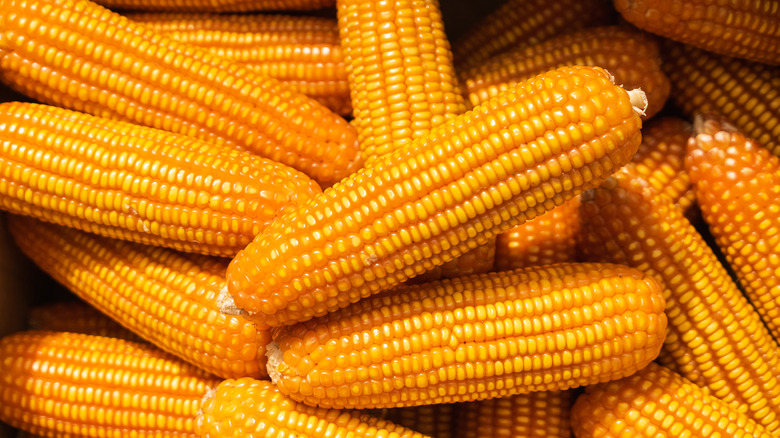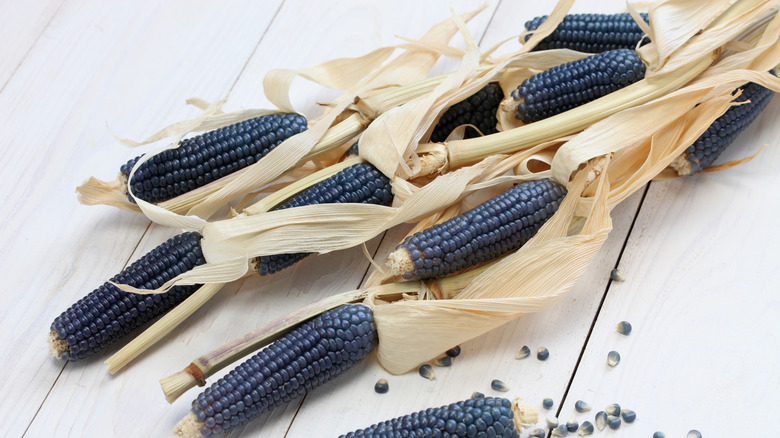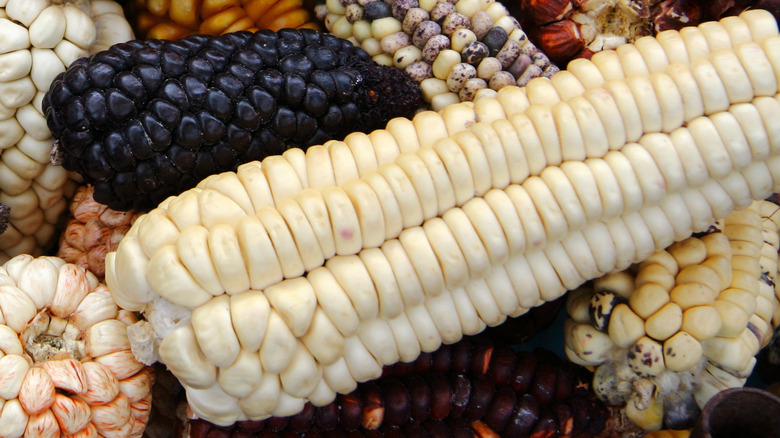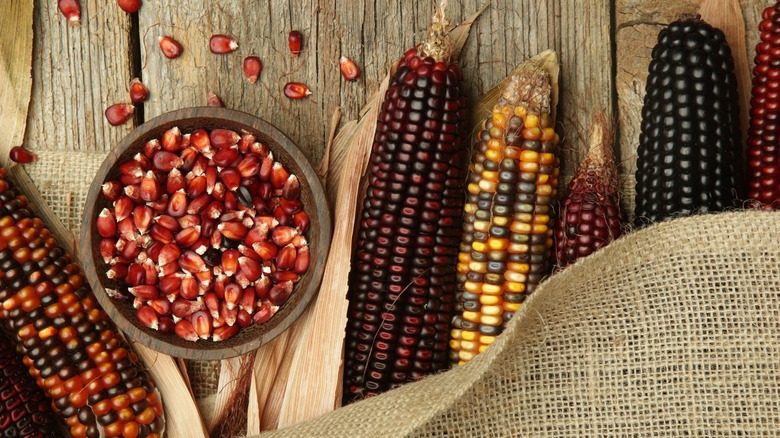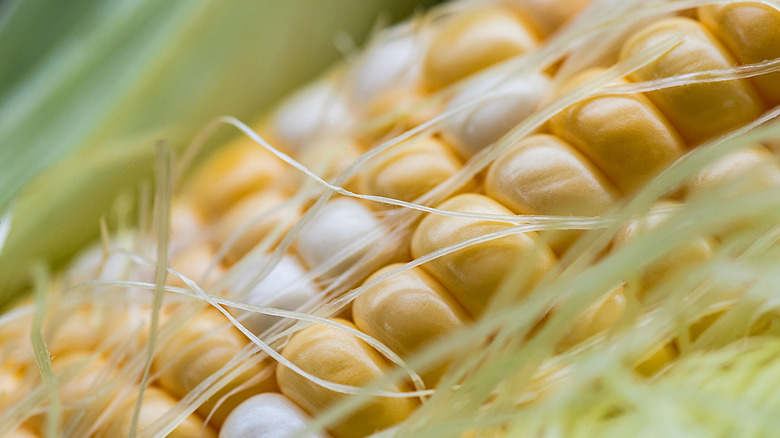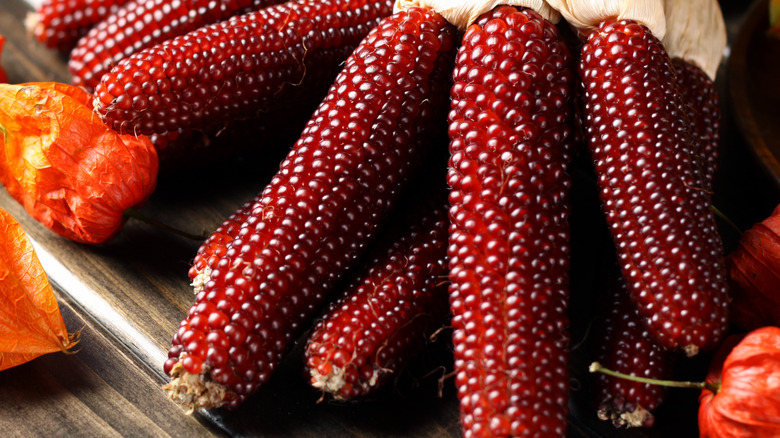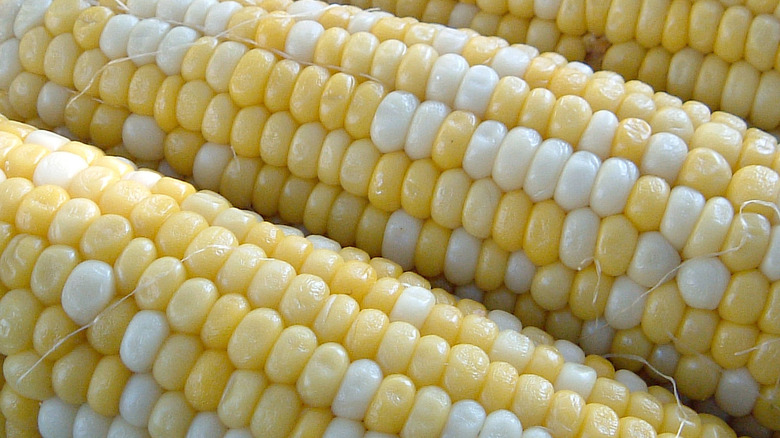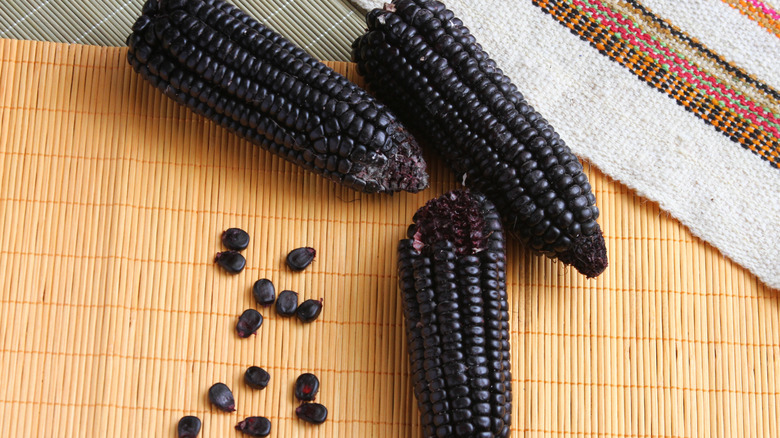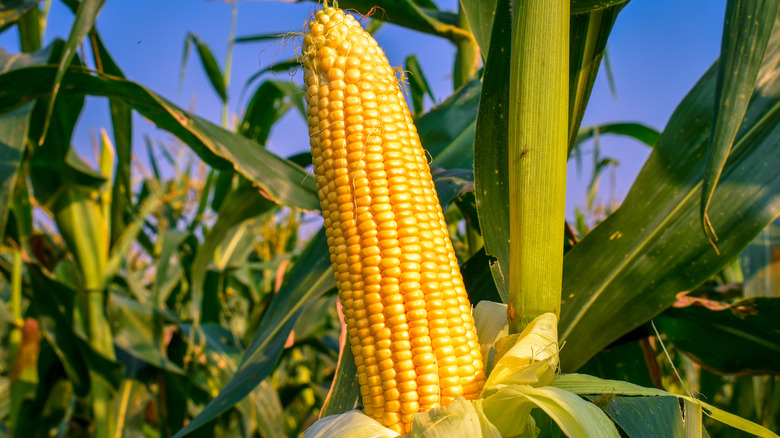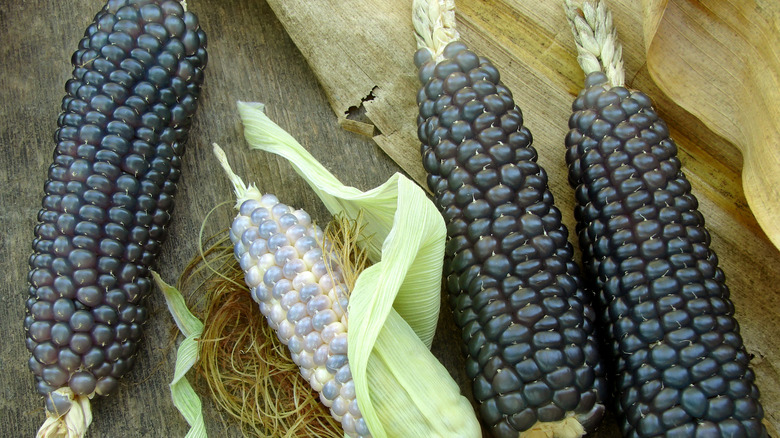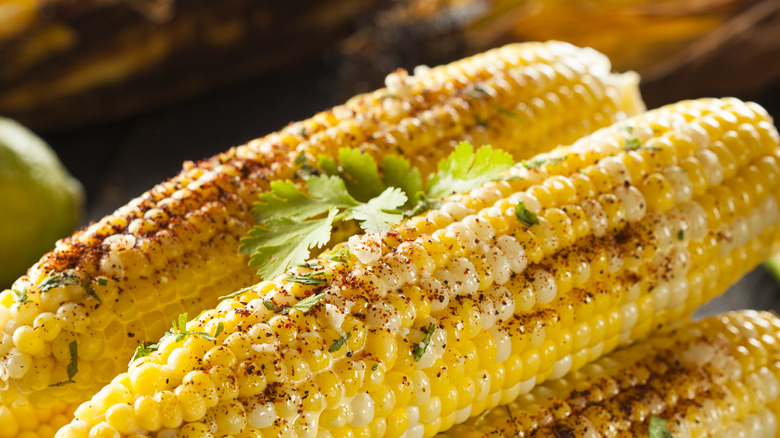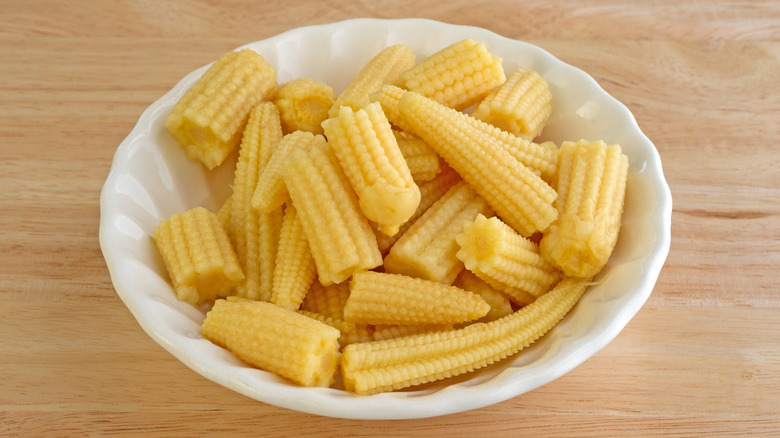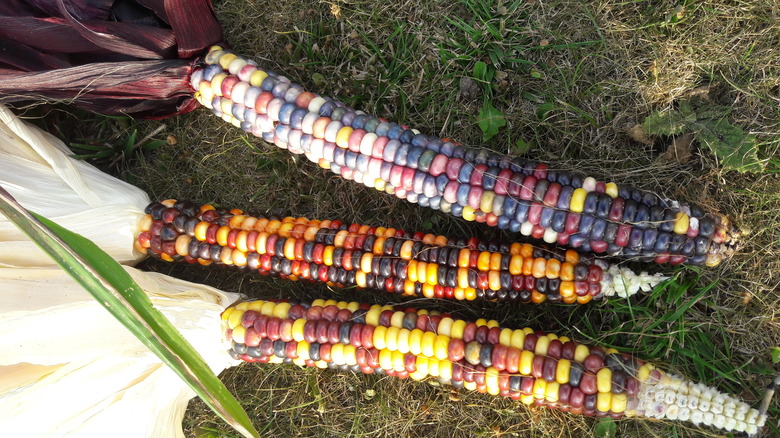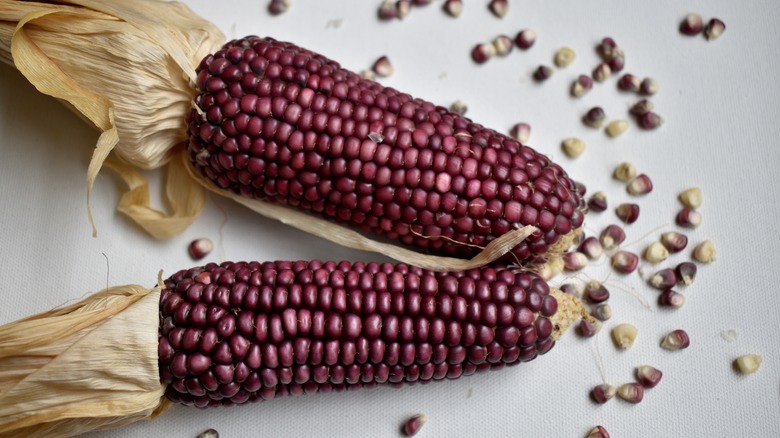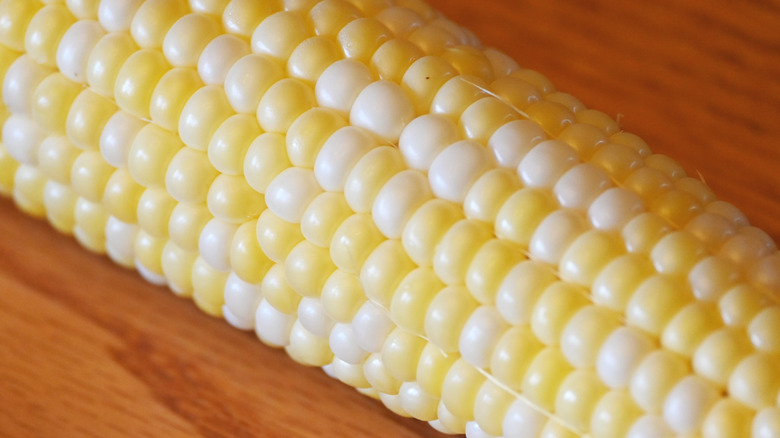14 Corn Varieties You May Not Have Heard Of
Corn: You love it, we love it, and everyone loves it. This fundamental cereal grain has been cultivated by humans for around 10,000 years and is both the basis and an ingredient of countless foods people eat daily. It can be enjoyed on its own, with a knob of butter placed gently on your corn on the cob. Or it can be refined into corn syrup and corn flour and used to flavor and texturize, ground into masa to make tortillas, or popped for the ultimate movie snack. There's no stopping these kernels.
But when you think of corn, you likely think of the classic yellow kind, right? It's easy to understand why. This traditional type of corn, known as field corn, is responsible for the vast majority of corn production in the United States. And because of this, it's easy to assume that's the only type of maize worth buying and consuming. But the truth is that there are dozens of varieties of corn out there, and they vary as much in their looks as they do in their usage. We wanted to showcase some of these majestic maize varieties. Let's take a look.
1. Hopi blue
At some point, you must have wondered how those blue chips that go down so well on game day get their color. And the answer isn't copious amounts of food dye (well, if you're dealing with a good brand, that is). As well as yellow, corn can be grown with vivid blue kernels, and Hopi blue corn is one of the main types to get to know. Hopi blue, long cultivated by the Hopi in Northern Arizona, is characterized by its long ears and vivid blue kernels. Planted in the spring, this plant grows to roughly five feet tall and is harvested once the season has given them enough time to flower and dry.
Hopi blue is a protein-rich maize variant and is known for being less impactful on your blood sugar than regular corn. While blue corn is best known for becoming bright blue tortilla chips, there's so much more you can do with Hopi blue. Grinding Hopi blue down to cornmeal (which can be done at home, using a regular coffee grinder) allows you to use it in corn muffins or bread. This maize is also exceptionally good-looking and can be dried out for decorative purposes. What it isn't suitable for, however, is eating directly off the cob, so make sure you prepare it properly.
2. Peruvian corn
Peruvian corn originates (as its name suggests) from Peru, and is a crop that's been grown for countless generations. This type of corn is notable for its white kernels, which grow slightly larger than field corn and can be somewhat drier overall. One advantage of Peruvian corn is how nutritious it is. This variety is rich in minerals and fiber and is especially rich in vitamin A.
As well as being versatile in nutrients, it is also versatile in the kitchen. Peruvian corn has a notably nutty flavor, but is mild enough to use in a multitude of ways. The ears of the corn can be served whole, in the same style as field corn, or the kernels can be stripped away and added to a wide range of meals. In Peru, it's often served as part of a stew named Pepian de Choclo, where it's cooked alongside aromatics like garlic and cilantro, as well as onions, and served along with other meals. It can also be milled into flour and used as you would with cornmeal, to make cornbread or corn muffins.
3. Flint corn
Field corn may be the predominant maize across the U.S., but within this, it has its own varieties. And one of these, flint corn, is a must-try. Flint corns are generally tougher than other types, which gives the variety its name, thanks to it having a stone-like hardness. The kernels on flint corn varieties are also generally shiny. One of the most striking things about some flint corn cultivars is their vibrant multicolored appearance. Some types, like Heirloom Flint Corn Fiesta, sport kernels of blue, gold, red, yellow, and black, creating a confetti-style kaleidoscope of color on your plate.
Flint corn can be trickier to use for culinary purposes, as the kernels are harder than sweet corn and other corn types. The best way to use them is usually when they're ground down into flour, which can then be cooked to make gruel or cornmeal. It may surprise you to learn, though, that flint corn is eaten widely across the world, in the form of popcorn. These kernels are the perfect texture to be popped and laden with butter, salt, and sugar.
4. Ambrosia hybrid
Anything that's named after the food enjoyed by classical gods is probably going to be pretty good. And luckily, the Ambrosia hybrid delivers. This delightfully sweet-tasting corn looks at first glance like any other corn variety, with bright yellow kernels, punctuated by the odd pop of white.
Where it stands out, however, is with its taste. Ambrosia hybrid has a buttery, sweet taste, with a savory edge to its flavor. The kernels are also high in moisture and can be cooked in the same way that regular corn can, either eaten straight from the cob or stripped off and added into whatever you please. For the best results, the Ambrosia hybrid should be planted toward the end of spring, so they can grow through the summer to their full height of over six feet. Once harvested, they should be eaten as soon as possible to take advantage of their full sweetness. If you'd like to eat them later on in the year, though, the good news is that this corn can be frozen effectively. Just strip the kernels from the cob and put them in a freezer container, and they should stay sweet for months.
5. Ruby Queen hybrid
If you like your maize with a little flair, the Ruby Queen hybrid is for you. Ruby Queen is a particularly impressive corn variety due to its ruby-red kernels. Coming into full maturity in just 75 days, Ruby Queen hybrid ears measure approximately eight inches when they're ready to be picked. Despite the deep red color, though, this corn has a traditional taste, with a gentle sweetness and tender, juicy kernels.
The Ruby Queen hybrid can do all of the things that regular corn can do when it comes to the kitchen. Cutting the kernels off and scattering them into a salad or a pasta dish can give your food an inimitable burst of color, almost like savory pomegranate seeds. If you wish, you could also grind it down into flour, and make yourself some red tortilla chips (although you may have to rely on some food coloring to accentuate the color, as some brands do). Or, if you just want to chomp on an ear of Ruby Queen with some salt and pepper, it'll go down a treat. Importantly, though, if you want to retain its vibrant tones, it's better not to boil Ruby Queen, as this will sap the color from the kernels and leave it looking drab.
6. Peaches and cream
This pleasing corn variety more than lives up to its name. Peaches and cream corn is known for their delicate hue, with a two-tone, pastel-like appearance. This sweet corn variety grows tall, with robust stalks that can reach up to seven feet in height. When allowed to grow to full maturity, peaches and cream ears may measure 10 inches in length, with a plentiful amount of kernels.
Peaches and cream is notably sweet in flavor, and unlike some other, tougher corn types, is easy to cook, strip, and eat. Thanks to its natural sweetness, peaches and cream is an excellent cultivar to use in desserts and sweet dishes. Try drying out peaches and cream plants, and then grinding it down into cornmeal, to produce a coarse flour that needs less added sugar. Or, if you don't want to lose the lovely color that peaches and cream kernels bring to the table, simply sprinkle them over an otherwise-savory salad, to give the meal a burst of sweetness.
7. Black corn
Look, most of us had a goth phase. And when we were going through ours, we wish we had known about black corn. This moody plant wouldn't look out of place on an Evanescence album cover, sporting deep black kernels that sprout from towering, three-meter-high stalks. Despite its dark appearance, black corn is a relative of standard yellow corn, and shares similar properties, including the size of its ears and kernels. While this corn variety can be found across the United States, it's generally not widely available and is more commonly grown and used in South America.
Like yellow corn, black corn kernels are sweet, although their sugar content isn't as high as what you might be used to. They're tender enough to be eaten from the cob when cooked and are also used to make masato, corn-derived alcohol. Black corn can also be ground into flour and used to make striking, dark tortillas and corn chips. Thanks to their dramatic appearance, black corn plants are also excellent for use outside of the kitchen, and when dried can make showstopping ornaments or centerpieces. Someone call Wednesday Addams, we've got just the corn for her!
8. Honey Select
There's sweet corn, and then there's really, really sweet corn. Honey Select falls into the latter camp. This corn variety is known as a TripleSweet type, specially produced for maximum sugar content. The result is a plant that looks as classic as they come, with pointed ears of corn nestled in fibrous green leaves, growing on tough, weather-resistant stalks. Taking roughly two and a half months to come to full maturity, this corn's kernels are crisp, full of moisture, and very sugary.
Honey Select is best grown when planted in mid-to-late spring so that it can be harvested during the hotter months of the year. It grows best in full sunlight, to help the kernels develop their high level of sweetness. This cultivar is pretty disease-resistant, so amateur horticulturists should have no problem getting them to full growth.
Thanks to their classic look, this corn is best consumed straight from the plant, by steaming the cobs lightly and seasoning them gently, before eating them as a snack. If you want, however, you can also freeze the kernels, as they will retain their flavor for months, and potentially even years.
9. Jagung Ketan Hitam
Some corn varieties are artworks in their own right, and jagung ketan hitam certainly falls into this category. This eye-catching corn is known for its irregularly-sized, deep purple corn kernels, which can be oblong, oval, and even round shapes. Jagung ketan hitam is predominantly cultivated and eaten in East and Southeast Asia, specifically Indonesia, where it's become a highly-prized and valued crop. In comparison to other corn ears, jagung ketan hitam ears are relatively short, usually between 17-22 centimeters lengthways.
According to Specialty Produce, jagung ketan hitam translates to "black sticky corn" and is particularly chewy, thanks to its high starch and low water content. As a result, it is often enjoyed grilled or steamed, with the cooking activating its stickiness. As with other corn, however, it can be used in stews, soups, rice dishes, and salads, as well as milled into flour. Jagung ketan hitam's gentle flavor makes it especially versatile. One area that this corn excels in, too, is its nutritional content. Its dark color is down to anthocyanin pigments, which can have a powerful antioxidant effect. Jagung ketan hitam also has good levels of certain B vitamins and vitamin C.
10. Earlibird
While corn is particularly good at growing in hotter climates, it can also be grown in slightly milder summer weather. Earlibird is a good example of one such corn, which is often found in Britain, where summer temperatures can be a little more gentle. Earlibird is a super-sweet corn, and when fully grown, turns into a bright yellow plant that's roughly 20 centimeters in length. Its kernels are generally a little smaller than other corns, but what they lack in size, they make up for in number, giving you little nubs of sweetness.
Earlibird corn is a good source of protein and fiber and can be eaten easily, directly from the cob if desired. One thing to watch out for when growing Earlibird, as well as other types of super-sweet corn, is cross-pollination. Planting this corn too close to other types you're growing may result in Earlibird losing its inherent sweetness. It's best to keep it to its own spot, so you can get maximum taste from your crop.
11. Baby corn
How do you make sweetcorn even cuter? Shrink it down and turn it into baby form, of course! Baby corn is corn in miniature size, and the term doesn't just apply to one type of maize, but rather any variety that's harvested early, usually after around a month and a half. Measuring way shorter and smaller than regular corn, baby corn can be eaten whole, with the kernels not yet at a size that can be stripped off. As it hasn't yet had a chance to develop all its sugars, baby corn is less sweet than full-grown corn, and instead is favored for its crunchiness.
Baby corn is more common in Southeast Asia, where it's often included in dishes like stir-fries and stews. It's also a common element in salads, where it can be sliced into chunks, or included whole. Due to its short shelf life, it can frequently be found canned, but if possible, it's worth enjoying fresh, to get the most from its crunch and taste. It's worth pointing out that baby corn isn't as nutritious as regular corn, as it hasn't yet had a chance to fully grow, but it has a solid amount of fiber per serving, with three grams per half-cup.
12. Painted Mountain
Few types of corn are as visually showstopping as Painted Mountain. These corn ears are frankly gorgeous to look at, with their kernels forming a varied mosaic of different colors. As with other corn, Painted Mountain grows best in the summer months and is fully mature and ready to harvest at around 70-90 days. They tend not to follow a set color pattern, but Painted Mountain corn kernels can be anything from the standard yellow to black and white.
Although this corn looks good, it can be trickier to eat in the style of other maize, as the kernels can be tougher. Instead, it might be easier to dry them out slightly and mill them. Once they've been reduced down to flour and meal, Painted Mountain corn can then be made into bread, tortillas, chips, muffins, and polenta — you name it, it can probably do it. They're also great to use decoratively.
13. Purple waxy corn
Okay, so we realize that describing an ear of corn as waxy probably isn't going to make you want to put it on your plate. But trust us when we tell you that you should give it a try. Waxy corn varieties, like purple waxy corn, are so named because the texture of their kernels is particularly starchy and slightly sticky, similar to sticky rice. This texture also gives the corn a wax-like appearance and gloss.
Waxy corn can be found in several locations, but varieties like purple waxy corn are grown extensively in eastern parts of Asia. Waxy corns lack a certain starch that exists in other corn varieties, which some people can find difficult to digest properly. Despite its tacky nature, it's still a good source of starch and nutrient-rich and has a gentle flavor that lends itself well to going in a lot of different meals. Purple waxy corn works particularly well with sweet flavors, but is equally at home in savory meals. Thanks to its starchy nature, it can also work as a thickening agent, when boiled down enough or ground into flour.
14. Picasso hybrid
You can expect any corn that's named after a famous artist to be pretty eye-catching. And eye-catching the Picasso hybrid certainly is. This corn type is especially notable for its outer appearance, with a visual appeal before it's even harvested. Its stalks and husks have a rich purple hue, with pops of pink in its outer tassels. Once opened, the husks reveal yellow corn studded with frequent white kernels.
Picasso hybrid corn is ultra-sweet, with a slightly earthy edge to each bite. Thanks to the tenderness of the kernels, you can eat it raw, pretty much immediately after cutting it from the stalk. This is also the best way to get the maximum sweetness from the vegetable, as over time, the corn's sugars convert into starches and it loses its taste. To contrast the sugars in the Picasso hybrid, though, we recommend roasting or grilling the ears to develop a char on the outside, which will enhance its natural nuttiness. Finish it off with some salt, pepper, lime juice, and zest, and you have a meal fit for royalty.
